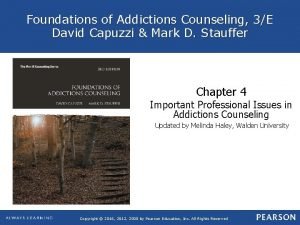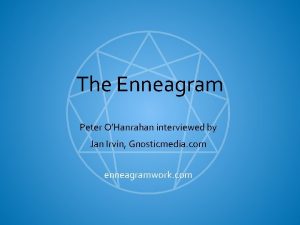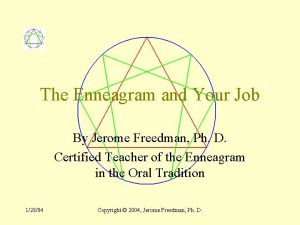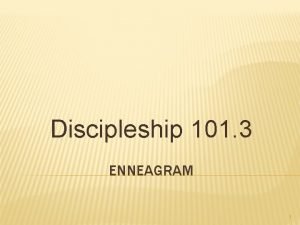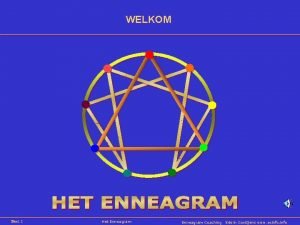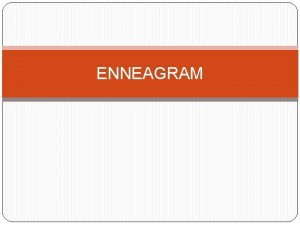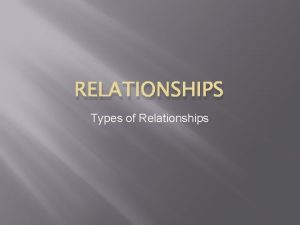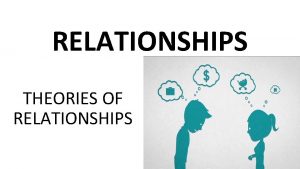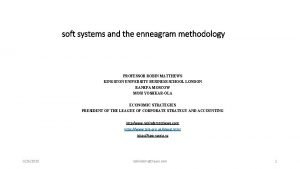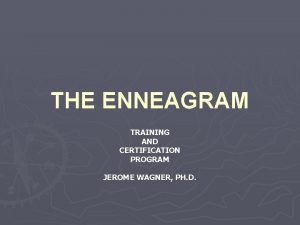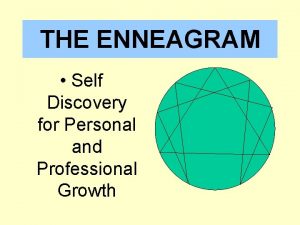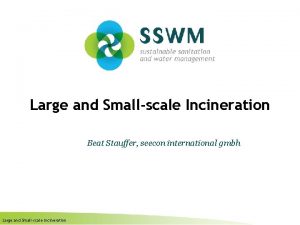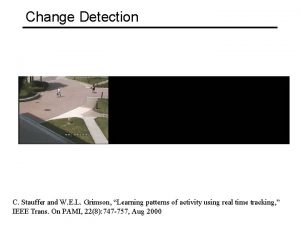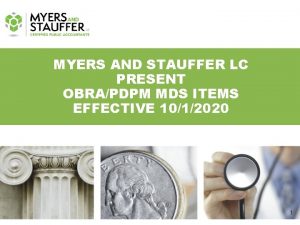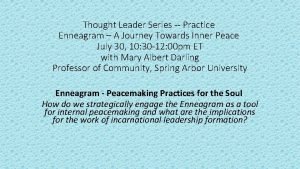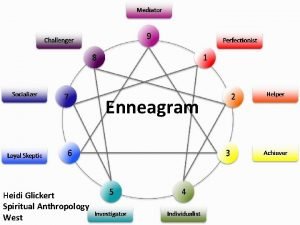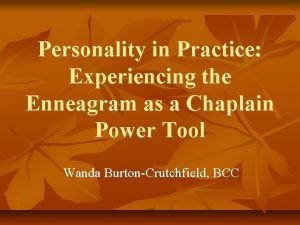Stauffer C 2019 The Enneagram and Relationships Online
![Stauffer, C. (2019). The Enneagram and Relationships [Online image]. Woodmont Christian Church. https: //woodmontchristian. Stauffer, C. (2019). The Enneagram and Relationships [Online image]. Woodmont Christian Church. https: //woodmontchristian.](https://slidetodoc.com/presentation_image_h2/06fee6ba11437787f776cc5f2a60ce3a/image-1.jpg)















![[Untitled illustration of an Enneagram Symbol]. Your Enneagram Coach. https: //www. yourenneagramcoach. com/blog/breakingdown-the-enneagram Now [Untitled illustration of an Enneagram Symbol]. Your Enneagram Coach. https: //www. yourenneagramcoach. com/blog/breakingdown-the-enneagram Now](https://slidetodoc.com/presentation_image_h2/06fee6ba11437787f776cc5f2a60ce3a/image-17.jpg)



















- Slides: 36
![Stauffer C 2019 The Enneagram and Relationships Online image Woodmont Christian Church https woodmontchristian Stauffer, C. (2019). The Enneagram and Relationships [Online image]. Woodmont Christian Church. https: //woodmontchristian.](https://slidetodoc.com/presentation_image_h2/06fee6ba11437787f776cc5f2a60ce3a/image-1.jpg)
Stauffer, C. (2019). The Enneagram and Relationships [Online image]. Woodmont Christian Church. https: //woodmontchristian. org/2019/09/the-enneagram-and-relationships/ Reliability and Validity of the Open Enneagram of Personality Scales (OEPS) Kayleigh Kastelein Mentor: Dr. Kristian Veit

Personality “the enduring configuration of characteristics and behavior that comprises an individual’s unique adjustment to life, including major traits, interests, drives, values, selfconcepts, abilities, and emotional patterns” (American Psychology Association, n. d. )

The Enneagram Theory • Basis • G. I. Gurdjieff • Oscar Ichazo • Claudio Naranjo • Don Richard Riso and Russ Hudson • Used in places such as Stanford University, U. S. Postal Service, and the CIA • Theory (Bland, 2010; Matise, 2007) Figure 2. The Enneagram with Riso-Hudson Type Names, 2017, retrieved from https: //www. enneagraminstitute. com/how-the-enneagram-systemworks. . Copyright 2017 by The Enneagram Institute®

Debated measure of personality Unethical to use in professional settings Current research is inconsistent and inadequate Why does the Enneagram matter?

How do we know if the Enneagram is “good” or “bad”?

Psychometrics Reliability (Consistency) Test-Retest Reliability Internal Consistency Reliability Validity (Truthfulness) Factor Analysis Convergent Validity

Time 2 Time 1 Relationship Test-retest reliability Correlation of test responses from time 1 to time 2 Over. 70 correlation needed to be adequate

Internal Consistency Reliability • Correlation between split halves Half 1 correlate Half 2 Construct Item 1 Item 2 Item 5 Item 2 Item 3 Item 6 Item 4 Half 1 Half 2 Item 5 Item 1 Item 6 Item 3 Item 4 Item 5 Item 6 Item 4 Item 3 • correlate Item 2 Cronbach’s Alpha Coefficient – calculate all possible split halves Over. 70 needed to be adequate

Convergent Validity correlating one construct with another similar construct Construct #1 Construct #2 Correlation

Factor Analysis • Statistical analysis to find latent factors within data • Confirmatory vs. exploratory factor analysis • Should see strong support for 9 factor model Test Item 1 Item 2 Factor 1 Item 3 Item 4 Item 5 Item 6 Factor 2 Item 7 Item 8 Item 9 Item 10 Factor 3

Background Information • Enneagram Assessments Wagner Enneagram Personality Style Scale (WEPSS) Riso-Hudson Enneagram Type Inventory (RHETI) Nine Type Temperament Model (NTTM)

Wagner Enneagram Personality Style Scale (WEPSS) Only Enneagram assessment in Mental Measurements Yearbook Small sample size Mostly college educated participants Test-retest -. 73 -. 88 Internal consistency -. 75 -. 81 • Sharp (1994) Factor analysis Found five-factor model • Overview Small sample sizes Lack of support from factor analysis More studies need done

Riso-Hudson Enneagram Type Inventory (RHETI) • Claims “scientifically validated test” • (Newgent, Parr, Newman, & Higgins, 2004) 287 participants Internal Consistency: 0. 56 to 0. 82 6 of 9 over 0. 70 Correlated with NEO-PI-R • Overview: Insufficient evidence Cronbach’s alpha Factor analysis Ipsative scale

(Yilmaz, Aydemir, Kesebir, Orek, Gencer, Yilmas, Unal, & Bilici, 2014) Nine Temperament Type Model (NTTM) • Test-retest • 990 students • Cronbach’s alpha of 0. 75 (range of 0. 68 -0. 83 ) • Factor Analysis • 990 participants • Adequate exploratory factor analysis • One unfactored, 3 partially factored, 5 fully factored • Good to Mediocre confirmatory factor analysis (Yilmaz, Unal, Palanci, Gencer, Orek, Tatar, Selcuk, & Aydemir, 2016) • Sample of 247 • Found significant correlations between Five Factor Model of Personality

(Yilmaz, Unal, Palanci, Gencer, Orek, Tatar, Selcuk, & Aydemir, 2016)

Table 2 Relationship between Big Five Personality Traits and Enneagram Traits Big Five Personality RHETI NTTM Extraversion Type 2 -0. 43 -0. 35 Type 3 -0. 44 Type 4 -0. 31 Type 5 -0. 39 -0. 67 Type 6 -0. 67 Type 7 -0. 45 -0. 57 Type 8 -0. 42 Conscientiousness Type 1 -0. 46 -0. 58 Type 2 -0. 35 Type 4 -0. 36 -0. 39 Type 7 -0. 30 -0. 58 Openness Type 2 -0. 30 Type 6 -0. 38 Type 7 -0. 33 Neuroticism Type 2 -0. 32 Type 4 -0. 49 -0. 43 Type 6 -0. 64 Agreeableness Type 2 -0. 34 Type 8 -0. 33 Type 9 -0. 46 -0. 51 note: all correlation coefficients are significant at the p <. 01
![Untitled illustration of an Enneagram Symbol Your Enneagram Coach https www yourenneagramcoach comblogbreakingdowntheenneagram Now [Untitled illustration of an Enneagram Symbol]. Your Enneagram Coach. https: //www. yourenneagramcoach. com/blog/breakingdown-the-enneagram Now](https://slidetodoc.com/presentation_image_h2/06fee6ba11437787f776cc5f2a60ce3a/image-17.jpg)
[Untitled illustration of an Enneagram Symbol]. Your Enneagram Coach. https: //www. yourenneagramcoach. com/blog/breakingdown-the-enneagram Now to my study…

Method • Participants acquired from 3 places: Amazon Mechanical Turk University students (through email) Social media • Survey in March and September Time 1 - 1039 participants Time 2 – 242 participants • Informed Consent Materials • Open Enneagram of Personality Scales (OEPS) • Big Five Inventory (BFI)

Why the Open Enneagram of Personality Scale (OEPS)? No studies done on the OEPS Free Option Perform similar study, but make improvements from previous research Large sample size Likert scale Hypothesis before research

Big Five Inventory (BFI) • Created by John, Donahue, and Kentle (1991) • 44 items • Internal consistency of. 83 • Correlated over. 70 with other Big Five personality assessments • Strong confirmatory factor analysis (all items correlating over. 90)

Demographics • Average age: 30. 1 • Majority women (57. 6%) • Majority white (69. 9%) • Majority from Mturk (49. 6) 47. 9% from university

Test-Retest Reliability Hypothesis: there will be a correlation greater than 0. 70 between time 1 and time 2 on OEPS types.

Table 5 Test-retest Reliability for OEPS Types and BFI Traits Trait Pearson correlation coefficient Type 1 0. 70 Type 2 0. 75 Type 3 0. 61 Type 4 0. 74 Type 5 0. 70 Type 6 0. 54 Type 7 0. 75 Type 8 0. 64 Type 9 0. 73 OEPS total 0. 68 Conscientiousness 0. 91 Extraversion 0. 86 Openness 0. 85 Agreeableness 0. 82 Neuroticism 0. 82 BFI Total 0. 85 Note. All p-values significant at the. 001 level Test-Retest Reliability Results • 6 of 9 OEPS types over. 70 • All BFI over. 82

Internal Consistency Reliability Hypothesis: Cronbach’s Alpha will be greater. 70.

Table 6 Internal Consistency of OEPS for Time 1 and Time 2 Scale Type 1 Type 2 Type 3 Type 4 Type 5 Type 6 Type 7 Type 8 Type 9 OEPS total Cronbach’s alpha time 1 0. 50 0. 46 0. 47 0. 48 0. 27 0. 55 0. 36 0. 56 0. 46 Cronbach’s alpha time 2 0. 49 0. 53 0. 17 0. 37 0. 50 0. 19 0. 51 0. 19 0. 67 0. 40 Internal Consistency Results

Table 6 Internal Consistency of the BFI for Time 1 and Time 2 Scale Cronbach’s alpha time 1 Cronbach’s alpha time 2 Extraversion 0. 90 0. 89 Agreeableness 0. 81 Conscientiousness 0. 78 0. 81 Neuroticism 0. 84 Openness 0. 76 0. 77 BFI Total 0. 80 0. 83

Convergent Related Validity Hypothesis: There will be correlations between Enneagram types and Big Five traits greater than. 30.

Table 2 Relationship between Big Five Personality Traits and Enneagram Traits Big Five Personality RHETI NTTM Hypothesis Extraversion Type 2 -0. 43 -0. 35 + + Type 3 -0. 44 Type 4 -0. 31 Type 5 -0. 39 -0. 67 Type 6 -0. 67 Type 7 -0. 45 -0. 57 + Type 8 -0. 42 + Conscientiousness Type 1 -0. 46 -0. 58 + Type 2 -0. 35 Type 4 -0. 36 -0. 39 Type 7 -0. 30 -0. 58 Openness Type 2 -0. 30 Type 6 -0. 38 Type 7 -0. 33 + Neuroticism Type 2 -0. 32 Type 4 -0. 49 -0. 43 + + Type 6 -0. 64 Agreeableness Type 2 -0. 34 Type 8 -0. 33 + Type 9 -0. 46 -0. 51

Table 2 Relationship between Big Five Personality Traits and Enneagram Traits Big Five Personality RHETI NTTM OEPS Extraversion Type 2 -0. 43 -0. 35 -0. 32 Type 3 -0. 44 Type 4 -0. 31 Type 5 -0. 39 -0. 67 Type 6 -0. 67 Type 7 -0. 45 -0. 57 -0. 54 Type 8 -0. 42 -0. 37 Conscientiousness Type 1 -0. 46 -0. 58 -0. 35 Type 2 -0. 35 Type 4 -0. 36 -0. 39 -0. 36 Type 7 -0. 30 -0. 58 Openness Type 2 -0. 30 Type 6 -0. 38 Type 7 -0. 33 -0. 31 Neuroticism Type 2 -0. 32 Type 4 -0. 49 -0. 43 -0. 37 Type 6 -0. 64 Agreeableness Type 2 -0. 34 0. 37 Type 8 -0. 33 Type 9 -0. 46 -0. 51 Hypothesis + + + - + +

Confirmatory Factor Analysis Hypothesis: It will not support a 9 -factor model.

Confirmatory Factor Analysis Results

Conclusion • The OEPS is not a reliable or valid source to use for the Enneagram. Mediocre test-retest reliability Poor internal consistency reliability Some convergent validity supported 9 -factor model not supported

Exploratory Factor Analysis

Discussion Limitation • • Self-report Not generalizable High attrition rate (77%) COVID? Future Direction • More studies done on Enneagram Assessments • More representative sample • No Pandemics • Karen Horney’s Theory and the Enneagram

References • American Psychological Association. (n. d. ). Personality. In APA dictionary of psychology. Retrieved February 4, 2021, from https: //dictionary. apa. org/personality. • Bland, A. M. (2010). The Enneagram: A review of the empirical and transformational literature. Journal of Humanistic Counseling, Education & Development, 49(1), 16– 31. • Matise, M. (2007). The enneagram: An innovative approach. Journal of Professional Counseling: Practice, Theory & Research, 35(1), 38 -58. • Newgent, R. A. , Parr, P. H. , Newman, I. , & Higgins, K. K. (2004). The Riso-Hudson Enneagram Type Indicator: Estimates of Reliability and Validity. Measurement and Evaluation in Counseling and Development, 36(4), 226– 237. • Sharp, P. M. (1994). A factor analytic study of three Enneagram personality inventories and the Vocational Preferences Inventory (Dissertation). Texas Tech University. • Wagner, J. P. , & Walker, R. E. (1983). Reliability and validity study of a Sufi personality typology: The Enneagram. Journal of Clinical Psychology, 39(5), 712– 717. • Yilmaz, E. Aydemir, O. , Kesebir, S. , Orek, A. , Gencer, A. , Yilmaz, A. , Unal, O. , Bilici, M. (2014). Validity and reliability of Nine Types Temperament Scale. Education and Science, 39(171). • Yılmaz, E. , Ünal, Ö. , Palancı, M. , Gençer, A. , Örek, A. , Tatar, A. , … Aydemir, Ö. (2016). The relation between the nine types temperament model and the five factor personality model in a turkish sample group. British Journal of Medicine and Medical Research, 11(4), 1– 11. https: //doi. org/10. 9734/BJMMR/2016/20303.

Interesting things to note
 Capuzzi and stauffer
Capuzzi and stauffer Kenny stauffer
Kenny stauffer Beat stauffer
Beat stauffer Peter o'hanrahan
Peter o'hanrahan 461 enneagram
461 enneagram 693 enneagram
693 enneagram Enneagram test similar minds
Enneagram test similar minds Enneagram direction of integration
Enneagram direction of integration Enneagram pentagram
Enneagram pentagram Enneagram test 144 vragen
Enneagram test 144 vragen Enneagram method
Enneagram method Hình ảnh bộ gõ cơ thể búng tay
Hình ảnh bộ gõ cơ thể búng tay Ng-html
Ng-html Bổ thể
Bổ thể Tỉ lệ cơ thể trẻ em
Tỉ lệ cơ thể trẻ em Gấu đi như thế nào
Gấu đi như thế nào Chụp tư thế worms-breton
Chụp tư thế worms-breton Chúa yêu trần thế
Chúa yêu trần thế Các môn thể thao bắt đầu bằng từ đua
Các môn thể thao bắt đầu bằng từ đua Thế nào là hệ số cao nhất
Thế nào là hệ số cao nhất Các châu lục và đại dương trên thế giới
Các châu lục và đại dương trên thế giới Công thức tính độ biến thiên đông lượng
Công thức tính độ biến thiên đông lượng Trời xanh đây là của chúng ta thể thơ
Trời xanh đây là của chúng ta thể thơ Mật thư tọa độ 5x5
Mật thư tọa độ 5x5 101012 bằng
101012 bằng độ dài liên kết
độ dài liên kết Các châu lục và đại dương trên thế giới
Các châu lục và đại dương trên thế giới Thơ thất ngôn tứ tuyệt đường luật
Thơ thất ngôn tứ tuyệt đường luật Quá trình desamine hóa có thể tạo ra
Quá trình desamine hóa có thể tạo ra Một số thể thơ truyền thống
Một số thể thơ truyền thống Cái miệng bé xinh thế chỉ nói điều hay thôi
Cái miệng bé xinh thế chỉ nói điều hay thôi Vẽ hình chiếu vuông góc của vật thể sau
Vẽ hình chiếu vuông góc của vật thể sau Thế nào là sự mỏi cơ
Thế nào là sự mỏi cơ đặc điểm cơ thể của người tối cổ
đặc điểm cơ thể của người tối cổ Thế nào là giọng cùng tên
Thế nào là giọng cùng tên Vẽ hình chiếu đứng bằng cạnh của vật thể
Vẽ hình chiếu đứng bằng cạnh của vật thể Phối cảnh
Phối cảnh
